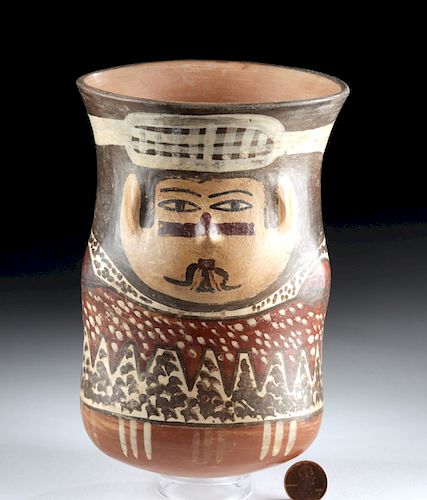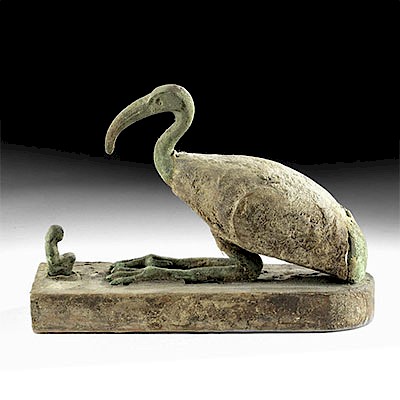Nazca Polychrome Figural Vessel of Lord or Shaman
Lot 174a
About Seller
Artemis Gallery
686 S Taylor Ave, Ste 106
Louisville, CO 80027
United States
Selling antiquities, ancient and ethnographic art online since 1993, Artemis Gallery specializes in Classical Antiquities (Egyptian, Greek, Roman, Near Eastern), Asian, Pre-Columbian, African / Tribal / Oceanographic art. Our extensive inventory includes pottery, stone, metal, wood, glass and textil...Read more
Estimate:
$900 - $1,200
Absentee vs Live bid
Two ways to bid:
- Leave a max absentee bid and the platform will bid on your behalf up to your maximum bid during the live auction.
- Bid live during the auction and your bids will be submitted real-time to the auctioneer.
Bid Increments
| Price | Bid Increment |
|---|---|
| $0 | $25 |
| $300 | $50 |
| $1,000 | $100 |
| $2,000 | $250 |
| $5,000 | $500 |
| $10,000 | $1,000 |
| $20,000 | $2,500 |
| $50,000 | $5,000 |
| $100,000 | $10,000 |
| $200,000 | $20,000 |
About Auction
By Artemis Gallery
Oct 31, 2019
Set Reminder
2019-10-31 10:00:00
2019-10-31 10:00:00
America/New_York
Bidsquare
Bidsquare : Fine Antiquities, Asian, Ethnographic Art
https://www.bidsquare.com/auctions/artemis-gallery/fine-antiquities-asian-ethnographic-art-4581
Our Halloween Day auction features classical antiquities, ancient and ethnographic art from cultures encompassing the globe, plus fine art. Artemis Gallery info@artemisgallery.com
Our Halloween Day auction features classical antiquities, ancient and ethnographic art from cultures encompassing the globe, plus fine art. Artemis Gallery info@artemisgallery.com
- Lot Description
Pre-Columbian, South Coast Peru, Nazca, ca. 100 to 400 CE. A polychrome figural vessel of a general cylindrical form with certain areas - most notably the face and shoulders - strategically protruding from the vessel. The figure is an elaborately dressed lord or shaman wearing garments that suggest highly symbolic animals of the Pre-Columbian world - all in a beautiful color palette of red, grey, creamy beige, caramel brown, and black hues. The dotted patterns suggest the spotted coat of a jaguar, while the jagged barbed motif suggests a serpentine creature. The man's visage is quite distinguished with almond-shaped eyes, arched brows, a batlike motif (perhaps face paint or a tattoo) over his protruding nose, a well-manicured goatee, and a brunette coiffure with sideburns topped by a decorative band featuring a checkerboard motif. Size: 4.5" in diameter x 6.5" H (11.4 cm x 16.5 cm)
The jaguar symbolized power and might throughout the Pre-Columbian world. Warriors, rulers, hunters, and shamans alike associated themselves with this king of beasts, the largest and most powerful feline in the New World. In fact, the principal Moche god wears a headdress adorned with a jaguar head and paws and important mortals donned similar headdresses. A nocturnal animal, the jaguar sleeps in caves and dark places and creeps quietly in the forest, evoking great mystery. Oddly enough, few ancient Andean artists would have actually scene jaguars as they are not indigenous to the coast. Jaguars prefer moist forest conditions. However, scholars believe that some cubs were transported over the mountains for rituals and it is also possible that some jaguars wandered down the coast.
The serpent is a fascinating element of Pre-Columbian iconography as well - as it was regarded to be a beneficial source of nourishment and at the same time quite deadly with its poisonous venom. Also important to the indigenous was the fact that snakes shed their skin annually, thus rejuvenating themselves and serving as symbols of renewal and good health.
Provenance: private Hawaii, USA collection; ex-private Hans Juergen Westermann collection, Germany
All items legal to buy/sell under U.S. Statute covering cultural patrimony Code 2600, CHAPTER 14, and are guaranteed to be as described or your money back.
A Certificate of Authenticity will accompany all winning bids.
We ship worldwide and handle all shipping in-house for your convenience.
#150502A stabilized fissure from the rim in the area of the headband and one across the base - professionally executed and difficult to discern. Collection label on underside of base.Condition
- Shipping Info
-
All shipping is handled in-house for your convenience. Your invoice from Artemis Gallery will include shipping calculation instructions. If in doubt, please inquire BEFORE bidding for estimated shipping costs for individual items.
-
- Buyer's Premium



 EUR
EUR CAD
CAD AUD
AUD GBP
GBP MXN
MXN HKD
HKD CNY
CNY MYR
MYR SEK
SEK SGD
SGD CHF
CHF THB
THB
















